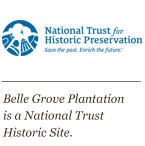Take-A-Stitch in the Quilt Honoring People Enslaved at Belle Grove
 Come be part of a powerful community project: the creation of memorial quilts honoring the 270 individuals enslaved at Belle Grove from the 1780s to the 1860s. Community members stitched the name and birthdate of each person onto fabric
Come be part of a powerful community project: the creation of memorial quilts honoring the 270 individuals enslaved at Belle Grove from the 1780s to the 1860s. Community members stitched the name and birthdate of each person onto fabric
blocks. Textile artist Carole Gary Staples of Ohio arranged these blocks into family trees, framed by vibrant African batik fabrics. Local quilt expert Pam Pampe prepared the quilts for hand quilting. The first quilt was completed and mounted on its frame last November. Now, we invite you to join us in the final steps of this tribute – hand quilting the second quilt, which we aim to complete by the end of March.
No prior quilting experience is required – you’ll have the opportunity to learn and practice hand quilting. All materials and instructions will be provided. There is no charge to participate.
Quilting Sessions at Bowman Library, 871 Tasker Road, Stephens City, VA 22655
January 7 12:30 PM – 4:30 PM
January 15 10:00 AM – 2:00 PM
January 20 10:00 AM – 2:00 PM
January 27 10:00 AM – 2:00 PM
February 7 1:30 PM – 4:45 PM
February 11 10:00 AM – 1:30 PM
February 17 10:00 AM – 2:00 PM
February 25 10:00 AM – 2:00 PM
March 7 1:30 PM – 4:45 PM
March 13 10:00 AM –12:00 PM
Help us stitch remembrance, honor, and community – one stitch at a time.
________________________________________________________
MORE ABOUT THIS PROJECT
In 2022 the exhibition Unearthing Enslaved Lives, about the archaeological investigation of the enslaved quarter site at Belle Grove opened. The curators sought input for how to include a memorial to the 270 individuals enslaved at Belle Grove. The idea of creating quilts displaying their names was suggested. The purpose was to remember these individuals, pay tribute to their lives, and share their stories with viewers. It was decided that the names of the enslaved people should be stitched onto quilt squares. The quilt blocks are arranged by family groups, whenever possible.
The quilt project was officially launched on August 4, 2022, during a special event at the Godfrey Miller Center, hosted by Belle Grove in partnership with the Winchester Chapter of the EGA (WEGA). Over the next year, community members, guided by the WEGA, embroidered the names and birth dates of 270 individuals enslaved at Belle Grove between the 1780s and the 1860s onto individual fabric squares. 
African American textile artist Carole Gary Staples of Ohio was commissioned to design and piece the quilt. She arranged the squares into family trees, surrounded by vibrant African batik fabrics, symbolizing cultural heritage. Carole determined that, to allow space to arrange the intricately stitched names by families, two quilts should be made. The top of the first quilt has already been completed. Local quilt expert Pam Pampe assembled the quilt, preparing it for the final stage: hand quilting.
Once completed, the two quilts will be permanently displayed in the Belle Grove Manor House. They will serve as a lasting tribute to the enslaved individuals whose names are intricately stitched into the fabric—a powerful reminder of their lives and legacies.


